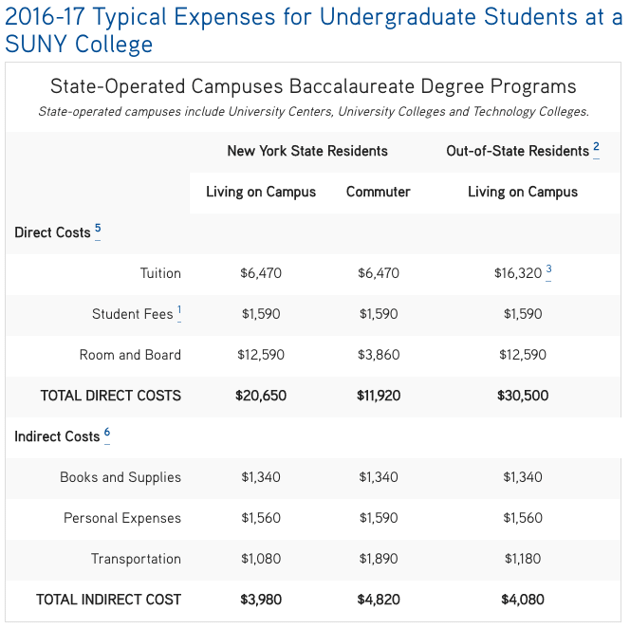Connecting state and local government leaders
Critics worry that the students who need the most help might be among the least likely to receive it.
New York Governor Andrew Cuomo recently announced plans to provide free tuition at the state’s public two- and four-year colleges to residents making up to $125,000. Standing next to former presidential contender Bernie Sanders just a couple weeks before the inauguration of Donald Trump, Cuomo reinvigorated a movement that some feared dead after the defeat of Sanders in the Democratic primary and deader than dead with Hillary Clinton’s loss. The governor’s declaration that "a college education is not a luxury—it is an absolute necessity for any chance at economic mobility” and his commitment to making sure that all New Yorkers have access to college “no matter what zip code they come from” was applauded on social media by Clinton, U.S. Education Secretary John King, and others.
It did not take long, however, for education researchers to highlight the potential flaws in his plan, the Excelsior Scholarships Program.
Matt Chingos, a senior fellow at the Urban Institute, published an editorial the day after Cuomo’s announcement arguing that the $163 million plan “does nothing for low-income students.” The Cuomo plan covers only the difference between a student’s existing aid and tuition. In New York, where tuition is already among the lowest in the nation ($6,470 at state universities, $6330 at city universities, and $4800 at two-year colleges), existing federal and state grants already cover tuition entirely for students from families making less than about $50,000. So students coming from the bottom half of the income bracket in New York will see no additional direct aid from this new plan.
Critics of this kind of last-dollar plan, as it’s known, point out that it only fills the gap left in funding; it doesn’t free up that funding for additional expenses, as first-dollar plans like those proposed by Sanders and Clinton during the presidential campaign would do. As Robert Kelchen, an assistant professor of higher education at Seton Hall University pointed out in a response to Cuomo’s announcement, students face many expenses in addition to tuition. A State University of New York website reveals that the in-state costs to attend the college beyond tuition and fees are $16,570 for on-campus students and $8,680 for commuters.

Free tuition, this table makes clear, does not make college free. And that is where Chingos and other critics take issue with Cuomo’s plan. Why not use the $163 million the state expects to spend on the Excelsior scholarships to help defray these additional expenses? Otherwise, the poorest students will likely still need to take on debt—if, that is, they are not dissuaded entirely from applying by the real cost of attendance, particularly after they have been told college will be free. The direct benefit of the Excelsior Scholarships will go to families making between $50,000 and $125,000, which is likely why Secretary King described the plan as “a bold step to eliminate financial hurdles” for middle-class families.
In an interview, Chingos explained that he was not making this point about low-income students as a judgment on whether this was the right policy to pursue. “I view my job as helping people understand the tradeoffs between free college and other things [the state] might do,” he said, adding that “what’s nice about free college is the simplicity and transparency. The downside is that it’s poorly targeted.”
In a conversation, Kelchen largely agreed with Chingos, that the plan “does nothing for low-income students who would already attend” a state college, but he did see some possible benefit for “those who might end up attending because of the message of free college, which is probably a few percent of students.” The example of Tennessee, which saw enrollment rise more than 20 percent at community colleges after the state made them free to attend, suggests that simplicity and transparency can indeed encourage students who have not traditionally applied to college to do so, although the benefits in New York are not expected to be as large.
Sara Goldrick-Rab, a professor of higher-education policy and sociology at Temple University in Philadelphia, is more optimistic about Cuomo’s plan. In an email, she described it as “terrific.” She is confident that it will benefit low-income students because it will impel new students, who otherwise wouldn’t, to apply college.
One of the barriers to low-income students applying to college is that the U.S.’s financial-aid system (FAFSA) makes it so that they do not know how much college is going to cost them until they apply. It is no surprise that some students assume they cannot afford college, even though they will in fact not have to pay tuition. “FAFSA simplification only helps those people who got college-ready earlier in high school,” Goldrick-Rab told me. Making it much easier to apply to college and letting students know early on what they can afford to do may have additional benefits. Recent research, she suggests, demonstrates that “if you view the future opportunity for college as open and affordable you exhibit more effort in high school.”
The problem with the power of the “free” message is that its allure is not limited to the neediest students. “Free” appeals to everyone, and the state’s public-university systems are likely to see a rise in applications from middle-income students, too, if this plan goes into effect. Susan Dynarski, a professor of public policy, education, and economics at the University of Michigan, said that Cuomo’s plan could do unintended harm to low-income and minority students, who, on average, perform less well on standardized tests, as they will be competing against an even larger pool of applicants. “Cutting prices across the board for 80 percent of the applicants is going to result in a surge in demand,” Dynarski pointed out, “and if they don’t expand capacity, the [state’s university systems] will have to ration in some way.”
When I asked the governor’s office about this danger, as well as the failure of its plan to present direct benefits to the neediest New Yorkers, a representative responded, “Our goal is to provide the most students with the greatest opportunity–and that goal is met by the Excelsior Scholarship Program.” Evasive as it might be and seeming to bolster the criticism that Cuomo’s plan borrows Sanders’ popular idea in preparation for a possible presidential run in 2020, the remark still raises a point that has been neglected by critics. Providing direct benefits to middle-income families might not be as off target as some believe when it comes to increasing college access.
Goldrick-Rab argues that “we have fooled ourselves into believing that the only people who can’t afford college right now and are genuinely constrained are the Pell recipients [who generally come from families making less than $50,000 per year].” The constraints are real for many families and students, even those with six-figure incomes. She based that claim on a randomized-control trial she has been running for the past four years in which she gave grants to Pell-eligible and non-Pell-eligible students to see if they increased their academic success. Sure enough, the grants did so for both groups, suggesting that need is not limited to low-income families.
There could also be an additional indirect benefit for low-income students to making college free for middle-income families. It is an adage in social-welfare policy that policy for poor people makes for poor policy. The more people who are included in the free-college system, Goldrick-Rab argues, the more likely it is to succeed, because with them comes voting power. This is where economics meets politics. Although it might be more economically rational to dedicate all the resources of the Excelsior Scholarship Program to low-income students, the political reality is that they might enjoy a greater benefit if wealthier New Yorkers also have a personal stake in the program. “A broader base of support,” Dynarski explained, “means stronger support.” Recall how easily Bill Clinton cut welfare benefits in the ‘90s. That was due, in part, to the fact that those cuts did not directly hurt the millions of people who voted for him. Social security, on the other hand, has proven very hard to cut because everyone has a piece of it, creating cross-class alliances.
Whether these optimistic predictions will bear out in New York—assuming Cuomo’s plan makes it through the legislature—is unclear. That uncertainty might well be the best reason for it to be passed. In his consideration of the plan, Kelchen invoked U.S Supreme Court Justice Louis Brandeis’s description of America as “50 laboratories of democracy.” New York is a particularly large lab, and its experiment is likely to play a large role in future educational-funding policy.
This article was originally published as part of The Atlantic's Next America: Higher Education project, which is supported by grants from the Bill & Melinda Gates Foundation and Lumina Foundation.

NEXT STORY: Seattle-Area Transit Agency Takes Major Step to Build a Zero-Emissions Bus Fleet



